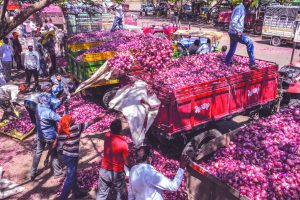 The recent spike in onion prices and the reaction of the government functionaries on the prevailing deficiencies in the trade and economy needs to be probed in the current context. The informed citizens of this country understand that the outbreak of onion shortage was not a sudden phenomenon.
The recent spike in onion prices and the reaction of the government functionaries on the prevailing deficiencies in the trade and economy needs to be probed in the current context. The informed citizens of this country understand that the outbreak of onion shortage was not a sudden phenomenon.
The excess rain in the months of September to November and consequent water logging in the onion fields of Maharashtra, the largest onion producing state in the country, led to the extensive damage of the crop. Hence there was enough indication of imminent scant arrivals of onion crop (kharif) in the grain markets across Maharashtra.
Ironically, during the same period, political parties, without an exception, were too absorbed in mathematics of pre-polls and post polls alliances for the state assembly elections. Had the same time and energy been invested in drawing plans for procurement and distribution of onion, it would have saved the livelihood of many producers.
There was enough time to save the urban consumer from agony of spiralling prices by making some advance arrangements with the sources inside and outside the country. Unfortunately, the lack of concern for common man on real issues has put the producers and consumers in jeopardy.
The election manifestos make tall claims of farmers’ welfare. The narrative of universal minimum income, minimising agricultural debt and better remuneration have become a cornball for the political outfits. Hitherto, no political party has taken measures to incorporate the sustainable solutions to the woes of farmers.
In the current scenario, most of the Maharashtra farmers, who lost their crop, had raised credit from lenders in organised and unorganised sector. As per government’s own estimates, the kharif crop of onion fell short by 30-40 per cent. The actual loss may be much greater because the methodology adopted in government survey excludes many effected farmers who fail to qualify for parameters decided by the state agencies.
A small farmer in Maharashtra pays a lease money of 12,000-18,000 per acre (amount depends upon the irrigation facility on field). Since substantial proportion of lease money is paid in advance, the dependence on commission agent is imperative. A loss of even 25-30 percent of crop leaves the cultivator with debt burden that cannot be repaid after the harvest. The farmers accumulate the debt one after the other season owing to the loss of crop and sometimes the interest burden becomes larger than the principal amount.
The agriculture debt-waivers announced by the respective state governments have a limited reach. The amount spent in the name of debt waiver should be invested to ramp up the irrigation network and post-harvest infrastructure. Like this year, in case of onion; every year many farmers lose their crops in different parts of the country due to non-availability of post-harvest infrastructure. The farmers lose their harvested crop lying in the fields for drying and sometimes the crop is rejected by the procurement agencies due to excess moisture content. The cultivators lament that even if there is a change in command at state and national level, the attitude of the policymakers towards the welfare of agriculture sector has remained unfazed.
Talking to Tehelka, Gunavant Patil, a farmer from Maharashtra and former President of Shetkari Sanghathan said that the government should either plan ahead to save the crop or should completely stay away from the market. The sudden intrusion of the government in the wake of protests by the urban consumers plays a spoilsport.
“When there is a free fall in the price, farmers suffer severe losses but government is sitting on the fence, on the contrary an upheaval in the retail market shakes the government and procurements are done from overseas market to combat the prices. Everybody knows but nobody accepts that it is middleman who makes a killing in such situations. The farmers are not earning an extra buck. We are not able to meet our per acre cost even if we get a relatively higher price because yield is too low. Our crop is purchased after grading and sorting and due to excess moisture, rejected by the buyers. Thus our per acre income is far less than the average income determined by the agriculture universities if the crop is effected by the weather vagaries, albeit, it may seem that farmer is getting richer by earning more per kilogram of produce.”
The problem of demand-supply mismatch of onion and consequent price fluctuations is not recent. Maharashtra farmers have been fighting for it for the past 80 years. “Our protests have highlighted the problem; political parties have lost power in the shadow of onion frenzy but nobody made since efforts to find and implement long term solutions”, added another farmer.
Farmer is a producer but does not have the marketing skills. He is not aware of the future trends in price. Onion is a perishable commodity so farmers need warehouse facility to retain the crop and sell at a suitable price in the market.
According to Dharmendra Malik, a senior leader of Bhartiya Kisan Union from Uttar Pradesh told that the sudden movements in the commodity prices benefit only the trader. He rued that the introduction of on-line trading of commodities has disturbed the price determination mechanism. As the physical delivery of commodities is not mandatory in the Commodity Act, the virtual transactions add to the woes of farmers. The on-line trading leads to artificial glut and scarcity in the market. Future trading should not be allowed as the price of the commodity cannot be anticipated.
The unregulated structure of Indian commodity market is responsible for the predicament of the farmers. In other parts of the world, a fixed premium over the minimum price decided by the government is allowed to the trader. But in our country, Minimum Support Price (MSP) is fixed, at the same time there is no check on the market price. He added that there should be a monitoring system on the profit earned by the traders. In the last five years or so, despite digitisation and roll out of tax reforms, the middlemen are thriving at the expense of small farmer.
When we face over-production and sell at rock-bottom price, government does not show an inclination to support us. Onion is grown in western Uttar Pradesh belt and our crop will hit the market by December end and January. The government has now placed orders for import so the import will coincide with our arrivals, and our own farmer will have to sell at lower price due to availability of cheaper imports. Can the political parties explain this?
The All India Kisan Sangharsh Coordination Committee, an umbrella organisation of over 120 farmer outfits has called for a ‘Grameen Bharat’ bandh on 8th of January, 2020 to protest against the apathy and inaction of the Central Government on the demands of the farmers. Avik Saha, a senior leader of the All India Kisan Sangharsh Coordination Committee told that the abrupt decisions of government on export and import of commodities has created a perception against India in global market. The flip-flops in commodity export-import have put our farmers at a disadvantage.
Saha said that in order to find a solution, we first need to accept that there is a problem. He regretted that government’s first line of defence is that there is no problem. This callousness of the government sent the economy in a tailspin. The problem should be diagnosed and treated well in time, else it would be too late.
letters@tehelka.com













